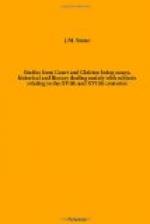Whether we agree with Caxton that “it might full well be aretted great folly and blindness to say or think that there was never such a king called Arthur,” or whether we are of those “divers men who hold opinion that all such books as be made of him be but fayne matters and fables, because that some chronicles make of him no mention, nor remember him nothing, nor of his knights,” we must admit that at least incidentally, the Morte d’Arthur is a picture of British faith and pious practices. Its composition is mediaeval, and represents the tone of thought common in the world as distinct from the cloister, in the Middle Ages; but it is also a true exponent of an earlier period still, when Lucius, the British chief, sent messengers to home to beg Pope Eleutherius to admit him into the Fold of Christ, and to send missionaries to instruct his people in the Faith. Comparing the Idylls of the King with Malory’s book, we are irresistibly reminded of certain Catholic books of devotion “expurgated” or “adapted” for members of the Church of England. All that savours too much of popery is left out. There is, no doubt, a strong Protestant prejudice in Tennyson, struggling with his sense of artistic beauty, and repeatedly Protestantism wins the day. We cannot always quarrel with him for his selection, because, although the modern mind is not a whit cleaner than the mediaeval mind, there is an unwritten convention, that at all events a spade shall not now be called a spade, at least in polite society, and Tennyson wrote exclusively for the polite. In the Middle Ages evil was spoken of plainly as in Scripture; there was no blinking of facts, no dressing-up of vice to make it look like virtue, and consequently much “bowdlerising” was necessary before Malory’s outspoken language should be sufficiently veiled to suit the susceptibilities, to which we have a perfect and legitimate right in so far as they are genuine, and no cloak for an hypocrisy that delights in the loathsome indecencies and disgusting suggestiveness of the modern problem novel.
But what we do regret is that apart from the coarseness, and even from a mere dramatic point of view, much that Tennyson rejected is finer than anything he took. His Lancelot is a grand conception, as mournfully, but with noble self-abasement, he says:
“. . . . in me there dwells No greatness, save it be some far-off touch Of greatness to know well I am not great.”
He is the very knight of courtesy, in chivalry above all other knights save Arthur—so strong that “whom he smote he overthrew”; he is brave, noble, scornful, and “falsely true,” but he is not the Lancelot of the Morte d’Arthur.
The story of Lancelot is incomplete in the Idylls, and by incompleteness we do not mean only that it is deprived of its denouement, of the climax up to which it has been working from the beginning, but that there is also to be noted the conspicuous absence of a refrain that should be there throughout. It is true that at the end of “Lancelot and Elaine,” one single line hints vaguely at the penance that was to atone for his sad and sin-stained life, where he is described as




